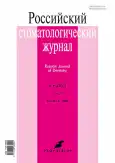Результаты выполнения костной пластики челюстей с применением ксеногенной кортикальной пластины BiOTECK
- Авторы: Брайловская Т.В.1,2, Абаев З.М.2, Михайлова А.П.1, Мамедов Х.И.1, Ведяева А.П.1,2
-
Учреждения:
- Национальный медицинский исследовательский центр «Центральный научно-исследовательский институт стоматологии и челюстно-лицевой хирургии»
- Первый московский государственный медицинский университет имени И.М. Сеченова (Сеченовский Университет)
- Выпуск: Том 27, № 6 (2023)
- Страницы: 533-540
- Раздел: Клинические исследования
- URL: https://journals.rcsi.science/1728-2802/article/view/254405
- DOI: https://doi.org/10.17816/dent482191
- ID: 254405
Цитировать
Аннотация
Обоснование. Основополагающим условием, определяющим эффективность лечения, а также его непосредственный и отдалённый положительный результат, является объём костной ткани челюстей в местах предполагаемой имплантации. Дефекты зубных рядов большой протяжённости и выраженная атрофия костной ткани челюстей вследствие потери зубов существенно ограничивают применение метода дентальной имплантации. Обоснованно расширить показания к применению дентальных имплантатов при атрофии костной ткани челюстей в местах их установки позволяет оптимизация хирургических методик, направленных на увеличение объёма костной ткани челюстей, таких как применение новых костно-пластических материалов для направленной костной регенерации.
Цель исследования — анализ результатов выполнения костной пластики челюстей с применением ксеногенной кортикальной пластины BiOTECK.
Материалы и методы. В исследование включены 22 пациента (11 мужчин и 11 женщин) с атрофией костной ткани челюстей, которым выполнена костная пластика с применением ксеногенной кортикальной пластины BiOTECK (BiOTECK, Италия).
Проведено динамическое клиническое и рентгенологическое обследование в три этапа: до костно-пластической операции — планирование дентальной имплантации для определения объёма костной ткани, имеющегося в наличии, и сопутствующих состояний и заболеваний; перед установкой дентальных имплантатов (через 6 мес после костно-пластической операции); перед началом ортопедического этапа лечения (через 12 мес после выполнения костно-пластической операции).
Результаты. Проанализированы и статистически обработаны результаты конусно-лучевой компьютерной томографии. Выявлено, что через 6 мeс после выполнения костной пластики с применением ксеногенной кортикальной пластины BiOTECK значения показателя «денситoметрическая плотность костной ткани челюстей» увеличились.
Непосредственно сразу после выполнения костной пластики с применением ксеногенной кортикальной пластины BiOTECK ширина костной ткани на верхней челюсти увеличилась в среднем на 5,0±0,1 мм, а ширина костной ткани на нижней челюсти — на 3,9±0,1 мм. К моменту начала I этапа дентальной имплантации (через 6 мес после выполнения костно-пластической операции) вследствие наблюдавшейся рeзорбции ширина костной ткани альвеолярного отростка верхней челюсти уменьшилась на 1,1±0,1 мм и составила 6,8±0,1 мм (степень рeзорбции — 13,9%), ширина костной ткани альвеолярной части нижней челюсти уменьшилась на 0,8±0,2 мм и составила 6,6±0,3 мм (степень резорбции — 10,3%).
Заключение. Полученные клинико-рентгенологические результаты через 1 год после установки дентальных имплантатов и выполнения костной пластики с применением ксеногенных кортикальных пластин BiOTECK свидетельствуют о стабильном уровне маргинальной костной ткани в области реконструкции альвеолярного гребня.
Полный текст
Открыть статью на сайте журналаОб авторах
Татьяна Владиславовна Брайловская
Национальный медицинский исследовательский центр «Центральный научно-исследовательский институт стоматологии и челюстно-лицевой хирургии»; Первый московский государственный медицинский университет имени И.М. Сеченова (Сеченовский Университет)
Автор, ответственный за переписку.
Email: Brailovsktv@mail.ru
ORCID iD: 0000-0003-0407-0885
SPIN-код: 6573-9590
д-р мед. наук, профессор
Россия, Москва; МоскваЗоимбек Мюратович Абаев
Первый московский государственный медицинский университет имени И.М. Сеченова (Сеченовский Университет)
Email: Sp5@zdrav.mos.ru
ORCID iD: 0000-0002-2866-690X
SPIN-код: 5655-8222
д-р мед. наук, профессор
Россия, МоскваАнна Павловна Михайлова
Национальный медицинский исследовательский центр «Центральный научно-исследовательский институт стоматологии и челюстно-лицевой хирургии»
Email: ana_tb@mail.ru
ORCID iD: 0000-0002-8941-0975
SPIN-код: 4358-0176
канд. мед. наук
Россия, МоскваХалил Илгам оглы Мамедов
Национальный медицинский исследовательский центр «Центральный научно-исследовательский институт стоматологии и челюстно-лицевой хирургии»
Email: halil2007@yandex.ru
ORCID iD: 0000-0002-2379-9324
SPIN-код: 6056-4445
Россия, Москва
Анна Петровна Ведяева
Национальный медицинский исследовательский центр «Центральный научно-исследовательский институт стоматологии и челюстно-лицевой хирургии»; Первый московский государственный медицинский университет имени И.М. Сеченова (Сеченовский Университет)
Email: vedyaeva@cniis.ru
ORCID iD: 0000-0002-7783-0841
SPIN-код: 2904-0361
д-р мед. наук
Россия, Москва; МоскваСписок литературы
- Becker W., Sennerby L., Bedrossian E., et al. Implant stability measurements for implants placed at the time of extraction. A cohort, prospective clinical trial // J Periodontol. 2005. Vol. 76, N 3. P. 391–397. doi: 10.1902/jop.2005.76.3.391
- Иванов С.Ю., Бизяев А.Ф., Базикян Э.А., Ломакин М.В. Стоматологическая имплантология. Москва : Всероссийский учебно-научно-методический центр по непрерывному медицинскому и фармацевтическому образованию, 2000. 65 с. EDN: ULYRFR
- Кулаков А.А., Лосев Ф.Ф., Гветадзе Р.Ш. Зубная имплантация. Москва : Медицинское информационное агентство, 2006.152 с.
- Козлова М.В. Атрофия альвеолярной части и отростка челюстей при остеопеническом синдроме у больных с патологией щитовидной железы и гипогонадизмом (современные методы диагностики и лечения) : автореф. дис. … канд. мед. наук. Москва, 2009. EDN: ZNUXMB
- Ушаков А.И., Серова Н.С., Даян А.В., и др. Планирование дентальной имплантации при дефиците костной ткани и профилактика операционных рисков. Часть 1. Лучевая диагностика // Стоматология. 2012. Т. 91, № 1. С. 48–53. EDN: PEKCVH
- Брайловская Т.В. Клинико-морфологическое обоснование концепции выполнения первично-восстановительных операций при повреждениях челюстно-лицевой области : автореф. дис. … канд. мед. наук. Москва, 2009. EDN: NKXHCT
Дополнительные файлы







